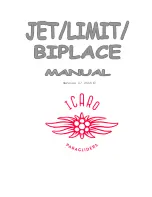
SECTION 8
CESSNA
HANDLING, SERVICE
MODEL 172RG
& MAINTENANCE
Generally, the painted surfaces can be kept bright by washing with
water and mild soap, followed by a rinse with water and drying with cloths
or a chamois. Harsh or abrasive soaps or detergents which cause corrosion
or scratches should never be used. Remove stubborn oil and grease with a
cloth moistened with Stoddard solvent.
Waxing is unnecessary to keep the painted surfaces bright. However, if
desired, the airplane may be waxed with a good automotive wax. A heavier
coating of wax on the leading edges of the wings and tail and on the engine
nose cap and propeller spinner will help reduce the abrasion encountered
in these areas.
When the airplane is parked outside in cold climates and it is necessary
to remove ice before flight, care should be taken to protect the painted
surfaces during ice removal with chemical liquids. Isopropyl alcohol will
satisfactorily remove ice accumulations without damaging the paint.
While applying the de-icing solution, keep it away from the windshield and
cabin windows since the alcohol will attack the plastic and may cause it to
craze.
PROPELLER CARE
Preflight inspection of propeller blades for nicks, and wiping them
occasionally with an oily cloth to clean off grass and bug stains will assure
long, trouble-free service. Small nicks on the propeller, particularly near
the tips and on the leading edges, should be dressed out as soon as possible
since these nicks produce stress concentrations, and if ignored, may result
in cracks. Never use an alkaline cleaner on the blades; remove grease and
dirt with Stoddard solvent.
LANDING GEAR CARE
Cessna Dealers' mechanics have been trained in the proper adjustment
and rigging procedures on the airplane hydraulic system. To assure
trouble-free gear operation, have your Cessna Dealer check the gear
regularly and make any necessary adjustments. Only properly trained
mechanics should attempt to repair or adjust the landing gear.
ENGINE CARE
The engine may be cleaned with Stoddard solvent, or equivalent, then
dried thoroughly.
CAUTION
Particular care should be given to electrical equipment
8-16
1 July 1979
CESSNA
SECTION 8
MODEL 172RG
HANDLING, SERVICE
& MAINTENANCE
before cleaning. Cleaning fluids should not be allowed to
enter magnetos, starter, alternator and the like. Protect
these components before saturating the engine with sol-
vents. All other openings should also be covered before
cleaning the engine assembly. Caustic cleaning solutions
should be used cautiously and should always be properly
neutralized after their use.
INTERIOR CARE
To remove dust and loose dirt from the upholstery and carpet, clean the
interior regularly with a vacuum cleaner.
Blot up any spilled liquid promptly with cleansing tissue or rags.
Don't pat the spot; press the blotting material firmly and hold it for several
seconds. Continue blotting until no more liquid is taken up. Scrape off
sticky materials with a dull knife, then spot-clean the area.
Oily spots may be cleaned with household spot removers, used
sparingly. Before using any solvent, read the instructions on the container
and test it on an obscure place on the fabric to be cleaned. Never saturate
the fabric with a volatile solvent; it may damage the padding and backing
materials.
Soiled upholstery and carpet may be cleaned with foam-type deter-
gent, used according to the manufacturer's instructions. To minimize
wetting the fabric, keep the foam as dry as possible and remove it with a
vacuum cleaner.
If your airplane is equipped with leather seating, cleaning of the seats
is accomplished using a soft cloth or sponge dipped in mild soap suds. The
soap suds, used sparingly, will remove traces of dirt and grease. The soap
should be removed with a clean damp cloth.
The plastic trim, headliner, instrument panel and control knobs need
only be wiped off with a damp cloth. Oil and grease on the control wheel and
control knobs can be removed with a cloth moistened with Stoddard
solvent. Volatile solvents, such as mentioned in paragraphs on care of the
windshield, must never be used since they soften and craze the plastic.
1 July 1979
8-17/(8-18 blank)












































